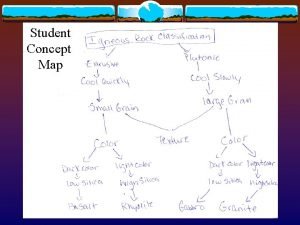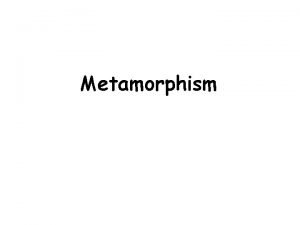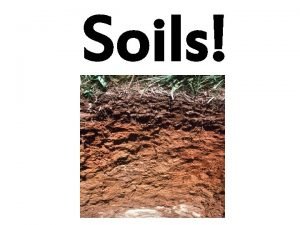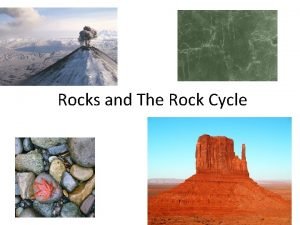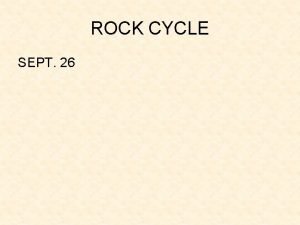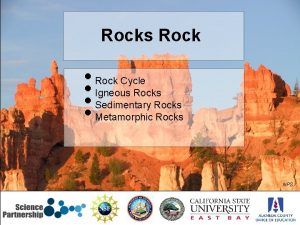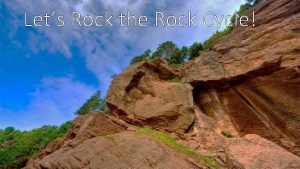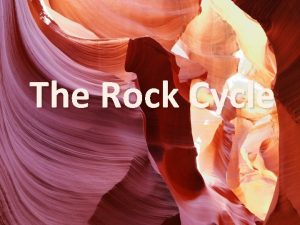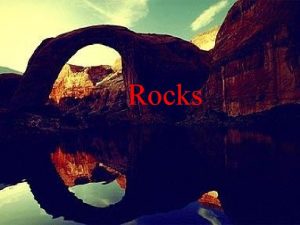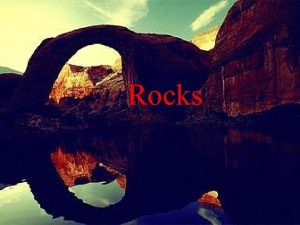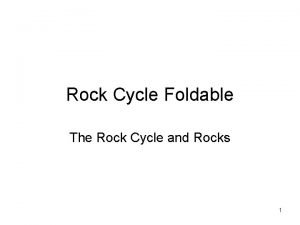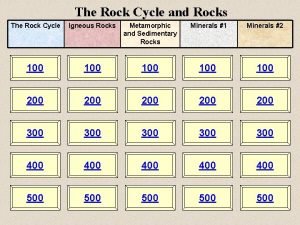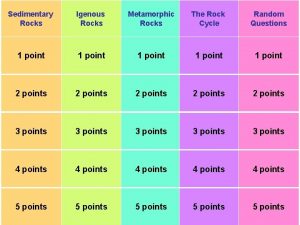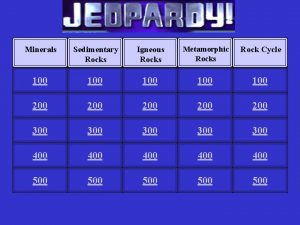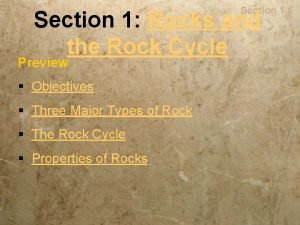Rocks and the Rock Cycle The Rock Cycle





































- Slides: 37

Rocks and the Rock Cycle

The Rock Cycle The continuous and reversible processes that illustrates how one rock changes to another. “One rock is the raw material for another”.

Rock Cycle Processes – Crystallization

Rock Cycle Processes - Weathering

Rock Cycle Processes - Lithification

Rock Cycle Processes Metamorphism

Characteristics of magma • Magma is molten rock that originates in the mantle, at depths of 100 -350 km. • Igneous rocks form from molten rock when it cools and crystallizes into the rock-forming minerals. • Magma that reaches the surface is called lava.

Igneous Rocks Volcanic (extrusive) igneous rocks form from lava on the surface. Plutonic (intrusive) igneous rocks from magma beneath the surface and are exposed later

Volcanic Rock – Rapid rate of cooling • Volcanic rocks crystallize from lava on the surface. • Lava contacts air and water and cools rapidly, inhibiting large crystal formation. • The most common volcanic rock is basalt.

Plutonic Rock – Slow rate of cooling • Plutonic rocks crystallize from magma in the interior of the crust, which are later exposed. • Magma is insulated and cools slowly, allowing large crystals to form. • Most common plutonic rocks are from the granite family.

Igneous Rock Classification • Texture – (overall appearance of rock, but especially pertains to mineral crystal size) – linked to how rock formed since crystal size depends on rate of cooling • Mineral composition – chemical makeup of magma or lava

Texture – Size and arrangement of crystals • Slow cooling rate promotes the growth of fewer but larger crystals • Fast rate forms many small crystals • Very fast rate forms glass – Overall appearance (vesicles, glassy etc. )

Phaneritic - Coarse-texture Granite

Aphanitic - Fine texture Rhyolite

Porphyritic – Bimodal crystal size • Large crystals, phenocrysts, form slowly from magma. • Magma erupts; crystals are suspended in an aphanitic matrix, the groundmass.

Glassy texture – indicates lack of crystalline structure due to rapid cooling Obsidian

Granitic (Felsic) Composition • Composed of primarily of light silicates • Contains high amounts of silica (Si. O 2) • Major constituents of continental crust.

Basaltic (Mafic) Composition • Composed of dark silicates and calcium-rich feldspar • More dense than granitic rocks • Comprise the ocean floor as well as many volcanic islands.

Sediment • solid rock or mineral fragments transported and deposited by water, wind, ice or gravity • dissolved minerals which evaporate or precipitate from water, or are secreted by organisms • accumulate over time as loose unconsolidated layer.

Sedimentary rocks form when sediment from weathered and eroded rock is compacted or cemented into solid rock Fig. 3 -2, p. 46

Sedimentary rocks • Formed by the lithification of sediment • compaction by burial • cementation by minerals from ground water • Sedimentary rocks contain evidence of past environments • Provide information about climate • Often contain fossils

Clastic Sedimentary Rocks composed of solid sediment from weathered rocks sandstone conglomerate organic shale

Chemical Sedimentary Rocks • Composed of minerals precipitated from surface or ground water (chemical sediment). • The upper picture shows rock salt on the Bonneville Salt Flats. • The lower photo shows veins of rock gypsum embedded in mudstone. • Both of these chemical sedimentary rocks are examples of evaporites.

Biogenic Sedimentary Rocks • composed of sediment of biological origin (e. g. shell fragments, plant material). • The upper photo is limestone, composed of an ancient coral reef in the Guadaloupe Mountains of Texas. • The lower photo is of bituminous coal. • COAL

Coal Formation

Metamorphic rocks form when heat, pressure or chemical reaction alters existing rocks Fig. 3 -CO, p. 44

Metamorphism The transition of one rock into another by temperatures and/or pressures unlike those in which it formed. Metamorphic rocks are produced from • Igneous rocks • Sedimentary rocks • Other metamorphic rocks

Metamorphism • Progresses incrementally (low to highgrade) • Rock remains solid throughout process • Agents of metamorphism – heat (between 150° and 800° C) – pressure (5 km below the surface the pressure is about 1500 x greater than atmospheric pressure – chemically-active pore fluids.

Heat – from the Geothermal Gradient or rising magma

Pressure from overlying rocks

Low grade to high grade Metamorphism (left-right)

Types of Metamorphism • Contact or thermal metamorphism – usually caused by contact of a rising magma body with host rock • Regional metamorphism (mountain building) – caused by tectonic plate interactions • Hydrothermal metamorphism – chemical alterations from hot, ion-rich water

Changes due to metamorphism • recrystallization of mineral grains and chemical precipitates • Formation of new, stable minerals • Foliation – parallel alignment of minerals due to pressure.

Foliation

Granite is a common parent rocks of Gneiss (“Nice”) Igneous Granite Metamorphic Gneiss

Sandstone is the parent rock for quartzite Sandstone - sedimentary Quartzite - metamorphic

Limestone is the parent rock for marble Limestone - sedimentary Marble - metamorphic
 Can igneous rocks form metamorphic rocks
Can igneous rocks form metamorphic rocks Igneous metamorphic sedimentary
Igneous metamorphic sedimentary Rocks
Rocks Extrusive vs intrusive igneous rocks
Extrusive vs intrusive igneous rocks Rhyolite and basalt
Rhyolite and basalt Concept map of sedimentary rocks
Concept map of sedimentary rocks Concept mapping of the different rock types
Concept mapping of the different rock types Chapter 3 standardized test practice answers
Chapter 3 standardized test practice answers Chapter 3 standardized test practice answers
Chapter 3 standardized test practice answers Contact and regional metamorphism venn diagram
Contact and regional metamorphism venn diagram How can one type of rock change into another type of rock?
How can one type of rock change into another type of rock? Bungee climbing
Bungee climbing How does soil link the rock cycle and biosphere?
How does soil link the rock cycle and biosphere? Rock types and cycle quick check
Rock types and cycle quick check Rock cycle explanation and diagram
Rock cycle explanation and diagram Hát kết hợp bộ gõ cơ thể
Hát kết hợp bộ gõ cơ thể Ng-html
Ng-html Bổ thể
Bổ thể Tỉ lệ cơ thể trẻ em
Tỉ lệ cơ thể trẻ em Gấu đi như thế nào
Gấu đi như thế nào Thang điểm glasgow
Thang điểm glasgow Hát lên người ơi
Hát lên người ơi Các môn thể thao bắt đầu bằng tiếng bóng
Các môn thể thao bắt đầu bằng tiếng bóng Thế nào là hệ số cao nhất
Thế nào là hệ số cao nhất Các châu lục và đại dương trên thế giới
Các châu lục và đại dương trên thế giới Công thức tính độ biến thiên đông lượng
Công thức tính độ biến thiên đông lượng Trời xanh đây là của chúng ta thể thơ
Trời xanh đây là của chúng ta thể thơ Mật thư anh em như thể tay chân
Mật thư anh em như thể tay chân Làm thế nào để 102-1=99
Làm thế nào để 102-1=99 Phản ứng thế ankan
Phản ứng thế ankan Các châu lục và đại dương trên thế giới
Các châu lục và đại dương trên thế giới Thơ thất ngôn tứ tuyệt đường luật
Thơ thất ngôn tứ tuyệt đường luật Quá trình desamine hóa có thể tạo ra
Quá trình desamine hóa có thể tạo ra Một số thể thơ truyền thống
Một số thể thơ truyền thống Cái miệng xinh xinh thế chỉ nói điều hay thôi
Cái miệng xinh xinh thế chỉ nói điều hay thôi Vẽ hình chiếu vuông góc của vật thể sau
Vẽ hình chiếu vuông góc của vật thể sau Biện pháp chống mỏi cơ
Biện pháp chống mỏi cơ đặc điểm cơ thể của người tối cổ
đặc điểm cơ thể của người tối cổ





